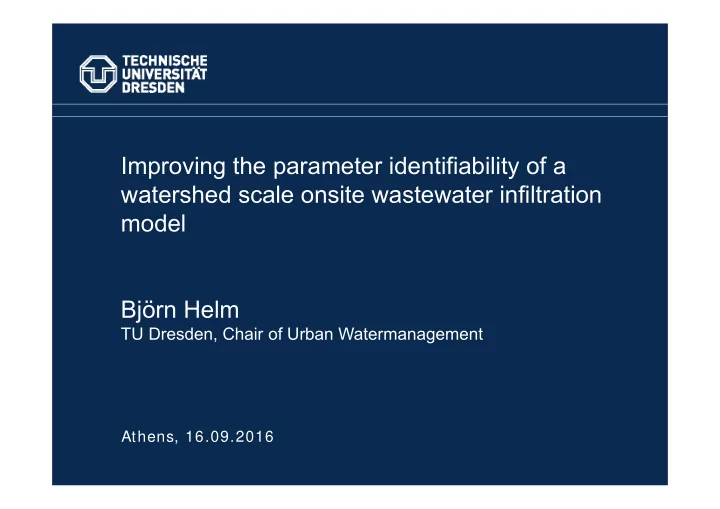

Improving the parameter identifiability of a watershed scale onsite wastewater infiltration model Björn Helm TU Dresden, Chair of Urban Watermanagement Athens, 16.09.2016
Motivation Infiltration based wastewater disposal globally • most frequent Pit latrines in low income countries, onsite • wastewater systems (OWS) in high income countries high local impact on groundwater quality • explanatory variables: • pit latrine density • groundwater level • hydraulic properties • few systematic monitoring studies! • Slide Nr. 2
Motivation Nitrate concentrations in house wells in Ukraine Slide Nr. 3
OWS Models site scale models: • conceptual reactive transport (Wilhelm et al. 1994) • coupled vadose zone and kinetic reaction models • (Heatwole et al. (2007), MacQuarrie et al. (2001)) cross scale approaches: • simplified aquifer with reactive transport (Wang • (2013) watershed models: • constant removal rate (Behrendt, 1998) • biozone mass balance (McCray et al. 2002). • Slide Nr. 4
SWAT OWS Module adapted from McCray (2002) • Biozone moisture balance percolation into / out of biozone • model unit: HRU • water balance of biozone • update hydraulic conductivity aggregation of OWS in one • unit Decay reactions BOD, fecal coliforms, TSS, N • daily time step • species, P species concen- tration and decay biozone below OWS as • additional soil layer Bacterial biomass (BB) balance BB concentration • mass balance of wastewater • BB growth, respiration, mortal- • constituents, bacteria and ity and slough off dead BB conversion to plaque • interaction with soil properties Soil properties • update field capacity OWS specific effluent values • update saturated moisture • content Slide Nr. 5
Parameters Parameter Explanation Unit Min Mean Max QSTE Pit latrine effluent discharge m 3 *d -1 0.05 0.1 0.2 cBODSTE Pit latrine effluent BOD concentration g*m -3 75 150 300 cTSSSTE Pit latrine effluent TSS concentration g*m -3 150 300 600 cFCSTE Pit latrine effluent FC concentration cfu*ml -1 50000 100000 200000 cNH4STE Pit latrine effluent NH4 concentration g*m -3 38 76 154 cNO3STE Pit latrine effluent NO3 concentration g*m -3 2 4 8 BzThk Thickness of biozone mm 25 50 100 BioD Density of biomass kg*m -3 900 1000 1100 CBODLBB BOD to LBB conversion rate - 0.21 0.42 0.84 CRespR LBB respiration rate coefficient d -1 0.008 0.016 0.032 CMortR LBB mortality rate coefficient d -1 0.0125 0.025 0.05 LCSlgR LBB sloughing rate coefficient d -1 0.000002 0.000004 0.000008 ECSlgR LBB sloughing rate exponent - 1.2 1.5 1.875 SlgRPlqCF slough off to plaque conversion coeff. - 0.020 0.039 0.078 CTSSPlq TSS to plaque conversion coefficient - 0.05 0.1 0.2 LCFC FC coefficient - 345 690 1380 ECFC FC exponent - 0.64 0.8 1 CBODDR BOD decay rate coefficient d -1 25 50 100 CFCBDR fecal coliform decay rate coefficient d -1 2.5 5 10 nitrification rate coefficient d -1 0.193 3.2 53 CNitrR denitrification rate exponent d -1 0.0045 0.0416 0.385 CDenitrR Slide Nr. 6
Parameters Parameter interrelation in SoE BzThk BODLB RespR MortR LSlgR ESlgR TSSPlq LFC EFC BioD BODDR FCDR NitDR DenDR BzThk 1 1 1 1 1 BODLB 1 1 1 1 RespR 1 1 1 1 MortR 1 1 2 2 1 LSlgR 1 1 2 2 1 ESlgR 1 1 2 2 1 TSSPlq 1 1 1 LFC 1 1 EFC 1 1 BioD 1 1 1 BODDR 1 FCDR 1 NitDR 1 DenDR 1 interaction 5 4 4 7 7 7 3 2 2 3 1 1 1 1 Slide Nr. 7
Sensitivity Global sensitivity and model performance Slide Nr. 8
Sensitivity Local sensitivity of parameters to NH4 concentration Slide Nr. 9
Sensitivity Correlation of local sensitivity indices for: build-up phase steady phase Slide Nr. 10
Model adaptations grouping of bacterial biomass parameters (ESlgR, • LSlgR, MortR, RespR) to LBB decay exponential sloughing rate constant (ESlgR) • biomass density (BioD) as a constant • exponential field capacity parameter (EFC) • constant BOD to biomass conversion constant • seven out of 14 parameters preserved Slide Nr. 11
Identifiability Collinearity as measure of identifiability Slide Nr. 12
Conclusions OWS algorithm in SWAT capable for regional • impact modelling adaptation for other systems e.g. pit latrines • possible algorithm highly collinear • systematic procedure for model adaptation • transferable to other models lag of benchmarking monitoring of OWS • impact Slide Nr. 13
Thank you for your attention Slide Nr. 14
Recommend
More recommend